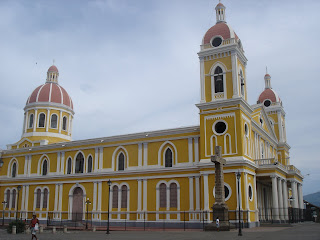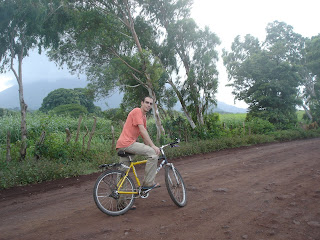 Pasamos la noche del 23 en Managua. La ciudad es peligrosa y teniamos que ir en taxi cuando saliamos ($2 por una carrera) Nos atrevimos a ir andando desde el hostal hasta la estación de buses para ver billetes hacia El Salvador. Estaba a tan solo una manzana (cuadra como dicen aqui) y nos paró un muchaho (pandillero). Empezó a decirnos lo peligrosa que era la ciuadad, que no fueramos por aquella calle que nos robarían, que no fueramos por la otra que aunque no llevaramos dinero nos quitaban la ropa para llevarse algo, etc. Nos dijo que era mejor que alquilaramos un taxi por una hora para ver la ciudad porque nosotros (especialmente Lauren por ser tan blanca) eramos como símbolos de dólar para la gente de alli. Tambien nos dijo que no pensemos que la gente es mala en Managua solo que tienen hambre y tienen que sobrevivir. Le dejamos hablar para no enfadarle y siguio contando cosas de Managua, de un asesinato que vio la noche antes y que aqui nadie les ayuda como en Europa asi que tienen que pelear. Acabó diciendo que nunca sabes cuando vas a morir aqui en Managua y si nosotros sabiamos cuando ibamos a morir. Le dimos la razón en todo y le dimos 10 córdobas para que comprara unos nacatamales. Así pudimos llegar a la estación de bus. Al salir tomamos un taxi directos a un centro comercial donde pasamos la tarde.
Pasamos la noche del 23 en Managua. La ciudad es peligrosa y teniamos que ir en taxi cuando saliamos ($2 por una carrera) Nos atrevimos a ir andando desde el hostal hasta la estación de buses para ver billetes hacia El Salvador. Estaba a tan solo una manzana (cuadra como dicen aqui) y nos paró un muchaho (pandillero). Empezó a decirnos lo peligrosa que era la ciuadad, que no fueramos por aquella calle que nos robarían, que no fueramos por la otra que aunque no llevaramos dinero nos quitaban la ropa para llevarse algo, etc. Nos dijo que era mejor que alquilaramos un taxi por una hora para ver la ciudad porque nosotros (especialmente Lauren por ser tan blanca) eramos como símbolos de dólar para la gente de alli. Tambien nos dijo que no pensemos que la gente es mala en Managua solo que tienen hambre y tienen que sobrevivir. Le dejamos hablar para no enfadarle y siguio contando cosas de Managua, de un asesinato que vio la noche antes y que aqui nadie les ayuda como en Europa asi que tienen que pelear. Acabó diciendo que nunca sabes cuando vas a morir aqui en Managua y si nosotros sabiamos cuando ibamos a morir. Le dimos la razón en todo y le dimos 10 córdobas para que comprara unos nacatamales. Así pudimos llegar a la estación de bus. Al salir tomamos un taxi directos a un centro comercial donde pasamos la tarde.De madrugada, el mismo taxista vino a recogernos para llevarnos a otra estacíon donde salen los buses para Bluefields. El bus salio a las 5am y llegamos al Rama a medido día. Allí tomamos una lancha rápida por el río Escondido que nos llevó, tras dos horas más, hasta Bluefields. Por el camino vimos algunas cabañas de indígenas a los lados del río (el río era muy ancho) como la de Sisi. Al parecer los habitantes de esta zona son de las tribus garífunas y miskitos. Es un viaje precioso. Lleno de vegetación y numerosas curvas me hizo pensar que John Grisham debio estar en un sitio como este cuando escribio "The Testament" un libro que transcurre en el Paraná de Brasil. Bluefields fue un protectorado inglés en la costa del Caribe de Nicaragua. No es muy bonito. Las tormentas son constantes como es habitual en la costa Caribe. La mitad de la población es negra, desdendientes de los esclavos que trajeron los ingleses. Estos hablan un ingles creole, difícil de entender. Otra parte de la población habla español, y una tercera parte habla miskito que era la lengua indígena existente antes de que llegaroan los españoles e ingleses.
Teníamos planeado ir a las islas del Maíz. Había un festival ese fin de seman llamado la fiesta del cangrejo! Cada 29 de Agosto celebran la abolición de la esclavitud en esta zona. Conocimos a dos chicas francesas muy simpáticas. Audrey y Sophie. Sophie es profesora de francés en Guayana Francesa y Audrey es enfermera y había estado trabajando en Bolivia y Perú. Ahora acaba de conseguir un trabajo con Médicos sin Fronteras y está a las espera de destino.
 El miercoles hicimos cola desde las 6am para conseguir los billetes. A las 7:15 abrieron la oficina y vendieron muy pocos billetes porque ya estaban reservados. Nos dijeron que había un barco privado (de mercancías) que tambien salía a las 9am. Hablamos con el capitán y conseguimos billetes. Montamos a las 8am y esperamos. Y esperamos. Y esperamos. A las 12pm aparece el capitán y dice que se baje todo el mundo porque hay gente que no ha pagado y porque hay sobrecarga. Tambien porque no hay salvavidas para todos. Vinieron con más salvavidas y literalmente la gente se tiro a por ellos como animales. La gente me aplastó contra unos sacos de patatas y me subí en ellos para gritar a todos que se calmaran y escucharan al capitán. Mientras un hombre me cogio del brazo para que me bajara de sus patatas, el capitán me dio salvavidas para Lauren, Audrey, Sophie y para mi. Después un revisor, un hombre con camiseta de hombreras y cuerpo de jugador de NBA vino con un bate de beisbol en mano a revisar que los pasajeros llevábamos billetes. Los extranjeros que estábamos en el barco no podíamos creerlo. Era como estar en una película. Nos hicieron salir y entrar al barco tres o cuatro veces (sin abrir las puertas si quiera si no saltando por la borda) A las 15:30 decidimos que ya era suficiente y decidimos irnos. Hablé con el capitán para que nos devolviera el dinero porque no ibamos a navegar de noche en un barco mercante sobrecargado (íbamos en el suelo sentados y tumbados unos junto a otros, parecido a los barcos de senegaleses que llegan a España.) Por la noche salimos a cenar con Audrey y Sophie y los cuatro probamos el ron Flor de Caña tan famoso en Nicaragua.
El miercoles hicimos cola desde las 6am para conseguir los billetes. A las 7:15 abrieron la oficina y vendieron muy pocos billetes porque ya estaban reservados. Nos dijeron que había un barco privado (de mercancías) que tambien salía a las 9am. Hablamos con el capitán y conseguimos billetes. Montamos a las 8am y esperamos. Y esperamos. Y esperamos. A las 12pm aparece el capitán y dice que se baje todo el mundo porque hay gente que no ha pagado y porque hay sobrecarga. Tambien porque no hay salvavidas para todos. Vinieron con más salvavidas y literalmente la gente se tiro a por ellos como animales. La gente me aplastó contra unos sacos de patatas y me subí en ellos para gritar a todos que se calmaran y escucharan al capitán. Mientras un hombre me cogio del brazo para que me bajara de sus patatas, el capitán me dio salvavidas para Lauren, Audrey, Sophie y para mi. Después un revisor, un hombre con camiseta de hombreras y cuerpo de jugador de NBA vino con un bate de beisbol en mano a revisar que los pasajeros llevábamos billetes. Los extranjeros que estábamos en el barco no podíamos creerlo. Era como estar en una película. Nos hicieron salir y entrar al barco tres o cuatro veces (sin abrir las puertas si quiera si no saltando por la borda) A las 15:30 decidimos que ya era suficiente y decidimos irnos. Hablé con el capitán para que nos devolviera el dinero porque no ibamos a navegar de noche en un barco mercante sobrecargado (íbamos en el suelo sentados y tumbados unos junto a otros, parecido a los barcos de senegaleses que llegan a España.) Por la noche salimos a cenar con Audrey y Sophie y los cuatro probamos el ron Flor de Caña tan famoso en Nicaragua. Decidimos volver a Managua el Jueves 27. Llamamos al mismo taxista que conocíamos (ya que nos habían advertido que en Managua algunos taxistas se organizan con ladrones para robar a los turistas y dejarles tirados en cualquier sitio.) Este taxista fue de confianza y le llamamos cada vez que lo necesitábamos. Al día siguiente, a las 4am de la mañana salimos hacia San Salvador, El Salvador. En el viaje pasamos por el sur de Honduras, que nos parecio calmado y donde solo pudimos ver algunas pintadas a favor de Micheletti. Pasamos por control de aduanas y narcóticos. Llegamos sin problemas a El Salvador. De momento hemos decidido no permanecer en Honduras por la situación actual pero es probable que lo dejemos para el final del viaje (unos diez días quizás.)
Decidimos volver a Managua el Jueves 27. Llamamos al mismo taxista que conocíamos (ya que nos habían advertido que en Managua algunos taxistas se organizan con ladrones para robar a los turistas y dejarles tirados en cualquier sitio.) Este taxista fue de confianza y le llamamos cada vez que lo necesitábamos. Al día siguiente, a las 4am de la mañana salimos hacia San Salvador, El Salvador. En el viaje pasamos por el sur de Honduras, que nos parecio calmado y donde solo pudimos ver algunas pintadas a favor de Micheletti. Pasamos por control de aduanas y narcóticos. Llegamos sin problemas a El Salvador. De momento hemos decidido no permanecer en Honduras por la situación actual pero es probable que lo dejemos para el final del viaje (unos diez días quizás.)






























 y de la matanza del cerdo.)
y de la matanza del cerdo.)







